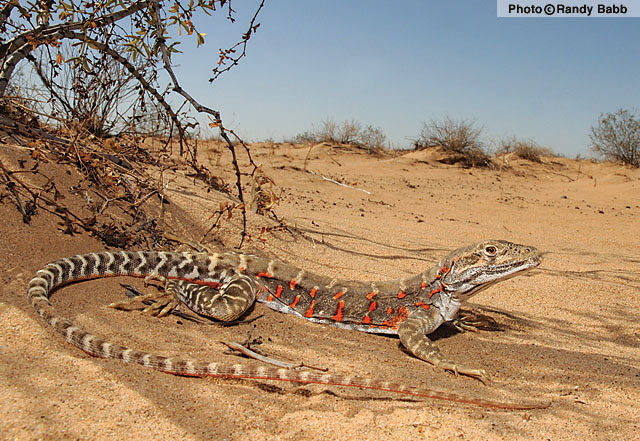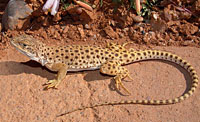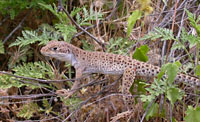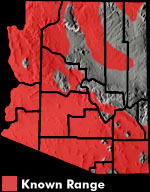Online Field Guide to The Reptiles and Amphibians of Arizona



Female. Yuma County, AZ
 Male. Mohave Co., AZ |
| LONG-NOSED LEOPARD LIZARD Gambelia wislizenii | |
|
DESCRIPTION: A large (up to 140 mm or 5.5″ from snout to vent) lizard with a large, elongated head and a long, rounded tail. This lizard is capable of changing its coloration and pattern. At times it is light tan to golden yellow with dark brown spots on the back, tail, and hind limbs. The same individual can become dark gray-brown with thin, light, lace-like lines across the back, tail, and hind limbs. When exhibiting light coloration the lace-like lines melt into the light background color and the dark spots stand out. When exhibiting dark coloration the dark spots melt into the background and the light lines stand out. Both lines and spots are visible when the lizard is between the two coloration/pattern extremes. The scales are small and granular. Gravid females have bright orange or red markings on the neck, sides of body, and underside of tail. HABITAT: Found in all four of Arizona’s desertscrub communities and Semidesert Grassland. Primarily an inhabitant of relatively flat, shrubby plains, valleys, and gently sloping bajadas with plenty of open space in which to run. BEHAVIOR: It is usually encountered during the day in the partial shade of low shrubs and bushes. It hibernates during the cold months of winter and late fall. At top speeds it lifts the forelimbs off the ground and runs on its hind limbs. It does not hesitate to bite when captured and it can easily draw blood with its powerful jaws. It may also hiss or squeak when captured. Unlike many of our lizards it can not cast off and regenerate its tail. DIET: This aggressive predator uses its powerful jaws to capture grasshoppers, beetles, moths, bees, wasps, caterpillars, other insects, lizards (including other Long-nosed Leopard Lizards), snakes, and small mammals. It occasionally eats some plant material including leaves and berries. REPRODUCTION: The Long-nosed Leopard Lizard mates in spring and lays a clutch of up to 11 eggs in spring or summer. Hatchlings begin to emerge in August. By Thomas C. Brennan Brennan, T. C., & A. T. Holycross. 2006. A Field Guide to Amphibians and Reptiles in Arizona. Arizona Game and Fish Department. Phoenix, AZ Brennan, T. C., & A. T. Holycross. 2005. A Field Guide to Amphibians and Reptiles of Maricopa County. Arizona Game and Fish Department. Phoenix, AZ Stebbins, R.C. 2003. A Field Guide to Western Reptiles and Amphibians, Third Edition. Houghton Mifflin Company, Boston, MA. |
|
Visit Partners in Amphibian and Reptile Conservation:


HOME
Copyright © 2023, Arizona Game and Fish Department. All rights reserved.
If you make use of the textual contents of this site in reports, publications, etc. please cite and credit the author(s) and photographer(s). All photos on this website are copyrighted. However, those found in the species account section may be used for any noncommercial scientific, educational, or conservation purposes provided that photographs are not altered and continue to bear the copyright symbol and name of the photographer. Please contact the photographer regarding commercial use of copyrighted photographs.











